How to configure Wonderware DASABCIP for unsolicited message handling
SUMMARY
For certain classes of critical alarms, it may be best to allow the PLC (Programmable Logic Controller) to notify the data clients immediately rather than waiting for a polling interval to update the alarm point at the HMI (Human Machine Interface). For this type of event, certain Allen Bradley PLCs have the ability to send unsolicited messages to clients. Once the PLC is properly configured via the RSLogix programming interface, an AVEVA ABCIP topic can be configured to accept unsolicited messages. Please refer to the Allen Bradley documentation for guidance on setting up the PLC network for unsolicited message configuration and support.
The ABCIP Communication Driver supports unsolicited messages from the following processors:
- PLC-5 and SLC 5/04 processors on the Data Highway Plus network.
- The following non-Logix processor configuration does not support unsolicited message handling:
MicroLogix with 1785-KA5 via ControlLogix Gateway (1756-DHRIO and 1756-ENB). - Logix5000 and MicroLogix 1100 processors on the Ethernet network.
- The following Logix5000 processor configuration does not support unsolicited message handling:
CompactLogix going through the EtherNet/IP interface module (1761-NET-ENI). - Logix5000, PLC-5, and SLC500 processors on the ControlNet network.
- The following SLC500 processor configuration does not support unsolicited message handling:
SLC500 using 1747-KFC15 interface on ControlNet via the ControlLogix Gateway (1756-CNB and 1756-ENB) to RSLinx on Ethernet.
For more information about supported processors, go to the AVEVA ABCIP documentation in the System Platform Management Console (SMC → Operations Integration Server Manager → Right-click Allen-Bradley → ABCIP → AVEVA Communication Drivers Pack → Allen Bradley → ABCIP Driver Online Help → Configuring the ABCIP Communication Driver → Device Groups and Device Items → Unsolicited Message Handling)
APPLIES TO
- AVEVA DASABCIP version 2.0 and higher
- AVEVA Operations Interface ABCIP version 6.0 and higher
PROCEDURE
- Open the System Platform Management Console (SMC) (Start -> AVEVA -> System Platform Management Console)
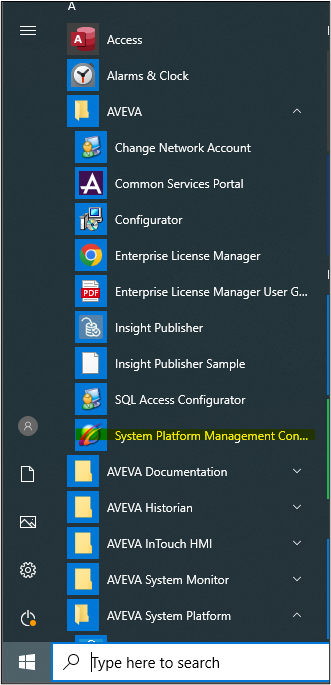
- In the SMC select Operations Integration Server Manager Snap-in, and expand until target OI.ABCIP.X Configuration level is exposed.
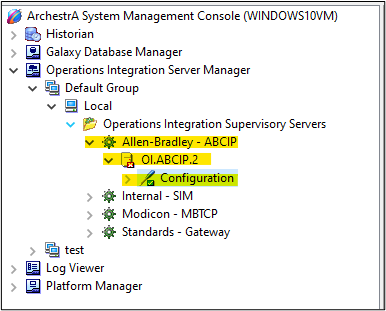
- Select and right-click on “Configuration” level. Create and configure the following objects (NOTE: These objects exist by default in the Communication Drivers Pack):
- PORT_CIP (logical representation of the Ethernet port for CIP communications in a computer),
- ENB_CLX (logical representation of the ControlLogix EtherNet/IP Bridge module),
- BACKPLANE_CLX (logical representation of the backplane communications bus of the ControlLogix rack) and
- LOGIX5000_CLX (logical representation of the ControlLogix processor)
Select the target controller (in our example it will be Logix5000).
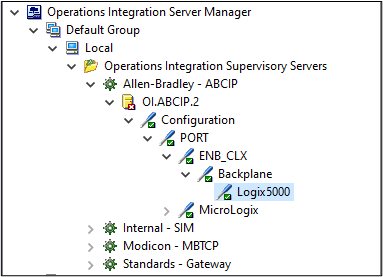
- In the right-hand pane of the SMC, you should see some configuration details related to the LOGIX5000_CLX object. Select the Device Groups tab from the target controller configuration and remove any topics there by default if you choose. Then, create a new topic (right-click on the pane).
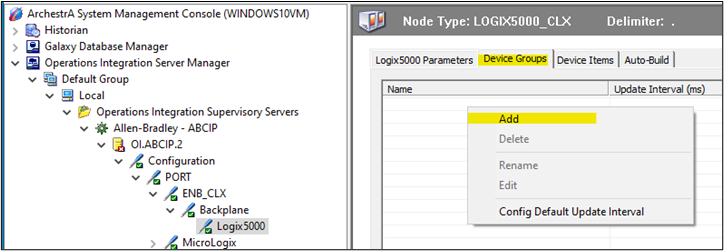
- The topic should be configured to accept unsolicited messages. To do that select the topic, right-click over the topic name and select Edit from the popup menu for additional configuration.
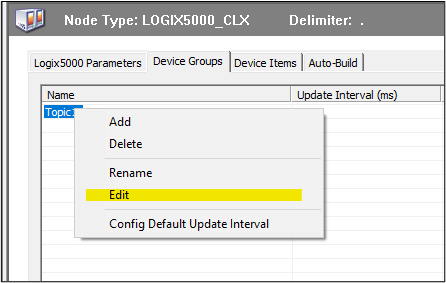
- On the resulting Device Group Parameters window, select the checkbox Support Unsolicited Messages and click OK.
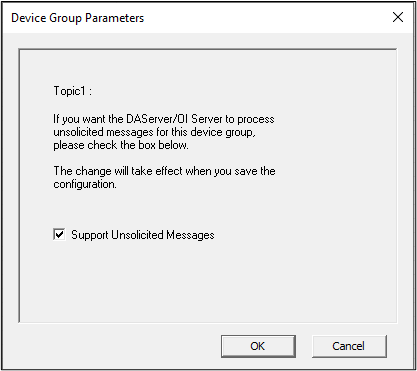
NOTE: Any topic can be configured to accept unsolicited messages. To configure a topic that only accepts unsolicited messages, you can set the topic’s update interval to 0. This will force the DA Server/OI-Server to poll the topic only once at startup and any update from the controller would need to be via unsolicited messages. This configuration could potentially cut down on message traffic in the process control network if properly implemented.
All Industrial Software Solutions Tech Notes are provided "as is" without warranty of any kind.